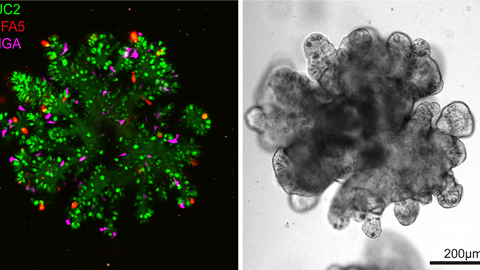This summer, we wrote about the polyisocyanide hydrogel protocol. Now, a team from Utrecht and Nijmegen has reported in PNAS that this gel has been used for the first time to grow 3D organoids in a completely animal-free environment.
This is unique because, until now, one gel has dominated research into growing such mini-organs for decades: Matrigel. “This is a material secreted by tumour cells that is grown in the abdomen of mice,” explains Professor Hans Clevers (Hubrecht Institute). ‘That process is now banned in the Netherlands, but huge numbers of mice are still used for harvesting it.’
Matrigel contains three extracellular matrix (ECM) components — laminin, collagen and fibronectin — that enable mini-organs to grow outside the body. In addition, it is completely transparent. ‘Another important property is that it is liquid at zero degrees Celsius, but at 37 degrees it becomes a gel,’ Clevers continues. ‘This creates a perfect environment for mimicking the extracellular matrix in which you can essentially grow organs indefinitely.’
Animal suffering
However, Matrigel is not without its drawbacks. ‘Because every mouse is different, every batch of Matrigel is also different. So you have to check whether the material you are using has roughly the same properties every time,’ says Paul Kouwer, Associate Professor at Radboud University. In addition, it is expensive, contains various other mouse proteins and, of course, involves a great deal of animal suffering.
The big question now is whether a synthetic version of Matrigel can be made. “All kinds of things have been tried worldwide, but nothing has really worked,” says Clevers. ‘In all attempts, either the growth process gets stuck, or the cultured organoids cannot be isolated from the gel. The biggest challenge was finding something that could mimic the ECM.”
The latter has now been achieved. Clevers’ group found a protein called invasin that enabled them to grow organoids in 2D. ’That has its applications, but the best approach is to do it in 3D. And that was possible with Paul’s PIC gel.” In PNAS, the researchers demonstrate that this new protein-gel combination is stable and comparable to Matrigel in terms of temperature behaviour. They also show that they can grow lung, small intestine and large intestine organoids. In addition, the PIC gel is easier to handle and transparent like Matrigel.
“The gels behave very similarly, with the major difference being that our PIC gel is identical every time,” says Kouwer. ‘Furthermore, the entire protocol no longer requires any animal products. Only the synthetic gel and Hans’ protein are required.”
Twenty years
The story of how Clevers’ group came to discover invasin is also remarkable. A few decades ago, Ralph Isberg (Tufts University School of Medicine) was working on the protein. Joost Wijnakker, who works in Clevers’ group, decided to take a chance and write to Isberg to ask if he had any of the protein left over. “It turned out he still had a twenty-year-old sample in the freezer,” laughs Clevers. ‘Apparently, it is so stable that it was still usable after all that time. It was doubly special because the first idea we wanted to test worked right away.’ Kouwer: ’In reality, things that you expect to work usually don’t. But, to everyone’s surprise, this one did!’
‘Everything we’ve tried with invasin works,’ continues Clevers. ‘Now that the structure has been clarified, it’s clear that it works in exactly the same way as laminin and fibronectin, the proteins that are active in Matrigel.’ Kouwer adds: ‘So far, we haven’t found any limits; everything grows in it.’ This makes the technology very widely applicable.
Billion
There is a great need for Matrigel worldwide, and therefore also for a replacement. Clevers is well aware of this. ‘Standardisation is currently a major stumbling block; the pharmaceutical industry is struggling with this. Matrigel is also very expensive for academics and contains hundreds of components whose effects are unknown. What we are offering with the PIC gel-invasin combination is lower costs for academia, the possibility of standardisation for industry, and the fact that laboratory animals are no longer needed.’
According to Kouwer, the Matrigel market is very large. “It’s worth a billion dollars and is used extensively.” So there are plenty of opportunities for the new material. However, the major advantage of PIC gel is also a minor obstacle. ‘Our gel always works in the same way, but the results will differ somewhat from what researchers are used to with Matrigel.’ For example, a PCA analysis of organoids in Matrigel or PIC gel will produce slightly different results. Not better or worse, just different.’
Introducing new technology is also often a lengthy process. ‘We published the first version of the organoids in 2009,’ says Clevers. ‘Wonderful papers were written about them for years, but it took a long time before they were widely used.’ He sees the same thing in the lab: when you introduce a new technology, people tend to fall back on what they know. ‘On the other hand, I also see that industry is extremely interested. You can’t completely replace animal testing, but organoids can fill a niche. If that can be done without using animal material, so much the better.’
Wijnakker, J.J.A.P.M. et al. (2025) PNAS 122(42), DOI: 10.1073/pnas.2507500122













Nog geen opmerkingen